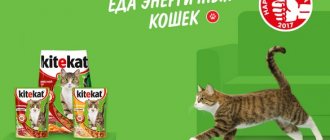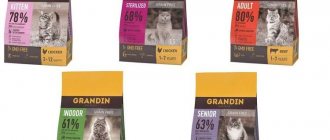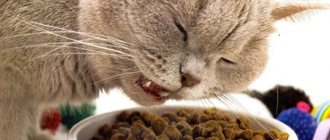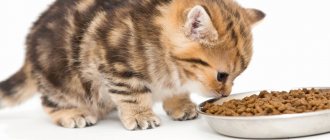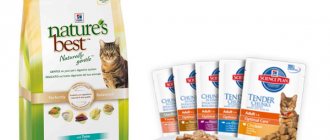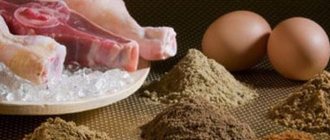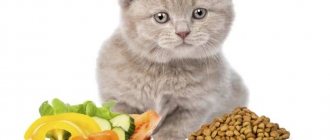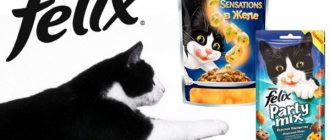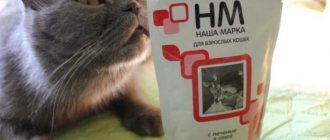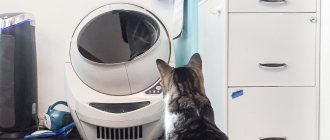What you need to know before buying cat food
Before purchasing, check the expiration date of the product. If there is a month or two left, don’t take it. Give preference to pellets that were produced this month, or at most last month.
Inspect the package carefully. It should not be torn or glued with tape. When the seal of the packaging is broken, fats begin to oxidize, which causes the taste to deteriorate, the quality and shelf life of the food to decrease. For the same reason, do not buy pellets by weight.
Avoid buying large packages, especially if you cannot provide proper storage conditions for dry cat food. Give preference to small packs. It’s better to go to the store one more time and buy a product that was released this month. This ensures that the cat eats fresh food, and the risk of it spoiling soon is minimal.
How to tell if food is spoiled
Eating stale food can lead to health problems for your pets. Therefore, many are interested in how to understand that a product is spoiled?
Storing dry food in a damp place for a long time leads to the appearance of an unpleasant odor, mold and swelling of the granules.
When stored for a long time in a very dry room, on the contrary, the granules become too hard, which is dangerous for pets. If the animal chews them with difficulty, they are spoiled.
When food comes into contact with air for a long time, it acquires the smell of rancid fat. This product should not be given to an animal.
Wet food made from bloated bags should also not be offered to your pets.
When, after feeding, there are pieces of meat left in the bowl that quickly dry out and darken, you should reduce the portion size in the future. It is better to throw away the spoiled product immediately before the animal decides to finish it.
It is strictly forbidden to feed domestic animals with a product that contains insects or their larvae.
How to properly store dry cat food
Dry food must be stored following the following rules:
- After opening the pack, pour the product into a container for storing granules. It is advisable that it be made of glass, food-grade tin or very high quality plastic.
- Limit air access. If there is no container, keep the dry food in the bag tightly closed by folding the top and securing it with a clothespin. If the package has a zip lock, press down on the package to squeeze out as much air as possible before closing it.
- New granules should not be mixed with those in the container. Leave them in a sealed container.
- When the food in the container runs out, it must be washed thoroughly before putting in a new one. Instead of detergents, it is better to use soda or salt so as not to cover the smell of the granules.
- If the pack is intact, it is better not to pour the dry granules into a container, but to transfer it there along with the packaging, wrapping the edges.
Where is the best place to store dry food?
Packages should not be kept in basements or on the ground. Firstly, rats can eat the granules, and secondly, mold can grow in the product, ticks and insects can settle in. It is better to keep the granules in a dry pantry or hallway.
Before deciding where to store dry cat food, keep these rules in mind:
- The place should be cool. The lower the temperature, the better. Keeping pellets near a heating appliance is a bad idea.
- Hide the product away from the sun, which stimulates oxidative processes. This leads to premature deterioration of the granules. Place the closed, or even more so open, package in a dark place.
- Keep the product only in a dry place. The granules quickly absorb water, swell, and deteriorate. In addition, a humid environment is a favorite place for mold and other harmful bacteria to grow. If the food becomes moldy, it must be thrown away.
The granules should be kept out of the cat's reach. Otherwise, she may get to them, eat them, or damage the packaging.
Storage conditions
Storage times and methods depend on the type of product. For example, dry granules in original packaging can be stored for up to 1.5 years . But after opening this period is significantly reduced. But for canned food and food in bags, the storage conditions and periods are radically different.
How to store dry granules
After opening the package, it is best to keep granular food in a cool, dry place for no more than 4-8 weeks . Storing it in a large package is not very convenient, since you need to constantly open and close it.
To prevent cat food from spoiling, you can pour some of it (the norm for 2-3 days) into a plastic or glass container so as not to yank a large bag every time. This will protect the granules from fresh air and prolong their original quality.
The optimal storage condition is a dark place, protected from direct sunlight. Suitable temperature is +20-25 °C with air humidity no more than 60%.
How to store wet food
Cans of canned food and wet food can be stored in sealed bags for a long time - approximately 3 years . It would be more correct to say before the expiration date. To prevent the product from spoiling due to exposure to high temperatures, it should be placed in the refrigerator.
Once opened, canned food is not stored for a long time; it quickly deteriorates . You shouldn’t leave it in a metal can even in the refrigerator. The food should be placed in a plastic container or bag and packed tightly.
Any wet food should be given to your pet within 1 day , maximum 2. After this time, fermentation processes begin in the soft product.
You should not leave canned food and pates on a plate if they have not been eaten. The next time they apply only such a dose that will be eaten without a trace.
How to store food in the refrigerator
Opened canned food is always placed in the refrigerator until the next meal. The optimal temperature is 4.5-8 °C . Opened cans are stored for no more than 2-3 days in an airtight plastic container, but not in a metal tin can.
Do not put food in the freezer . This rule applies equally to wet and dry products. Exposure to sub-zero temperatures will negatively impact taste and quality.
Dry granules should not be placed in the refrigerator. High humidity levels and too cold temperatures can have a negative impact on the pellets. The optimal place is a darkened shelf or pantry .
How can you store food?
The most important rule when choosing storage containers is the tightness of the packaging . Containers can be made of different materials:
- Metal.
- Plastic.
- Glass.
- Porcelain.
Also, do not choose jars that are too large . The larger the container, the more oxygen.
Plastic containers have a number of advantages:
- Low price.
- Ease of use.
- Little weight.
But such containers also have negative sides. Plastic absorbs odors and gets dirty quickly.
The danger of using metal cans is that iron can react with the food , which will negatively affect the quality and taste. The safest from an environmental point of view are containers made of glass and porcelain. Transparent jars are placed in a dark place , but for opaque porcelain this requirement is not necessary.
How to Store Wet Cat Food
Canned food is made from meat that has been previously deboned. Plus vegetables, cereals, and other ingredients are added. Many veterinarians consider it healthier than dry, but if stored incorrectly, the pet can be poisoned within a few hours after opening the package.
Before choosing a place to store liquid cat food, keep these rules in mind:
- Never buy canned food that has expired.
- The contents of the opened bag that the pet has not eaten should be immediately transferred to a container and placed in the refrigerator.
- Before giving canned food to your cat, transfer the product to a bowl. If it is in an open tin can, the pet may be injured.
- When the jar is hermetically sealed but there is a dent, don’t buy it. If it appears at home after a fall, the product should be used immediately.
- If you open the can and don’t like the contents, don’t give it to the cat.
Give your pet as much product as he can eat. Canned food should not lie in a bowl all day - it dries out, loses its usefulness, and can be poisonous. If your cat doesn't eat the canned food in the bowl, put it in the refrigerator. If you have not done this within an hour, the food should be thrown away.
Where to store wet food
The storage condition for wet cat food is a cool, dry place if it is in a hermetically sealed container. After opening, the food should only be kept in the refrigerator, transferred to a container (glass jar) with a lid.
How long to store
According to my observations, the maximum adequate storage time for food after opening the package and subject to the above storage recommendations is 2 months. During this time, it does not dry out, does not go rancid, and the cat eats it with pleasure.
Based on this, calculate the size of the pack of food. For example, if you have one pet, then do not buy a package weighing more than 3 kg.
If there are more cats, then you can buy both 5 and 10 kg - options for breeders or for those who have 2,3 or more cats.
Health to your cats.
How long can cat food be stored?
The shelf life of both wet and dry cat food is indicated on the label. If it has expired or you have stored it incorrectly, the product should be thrown away. In order not to accidentally expire, place the food whose shelf life ends faster in the first rows.
Expiration date and storage rules for unopened packaging
Typically, the shelf life of cat food ranges from 1 to 3 years, less often – up to five. Food should be stored in a dry, cool place, away from light. Recommended storage temperature is from 5 to 20°C. Canned food cannot be frozen. In summer it is better to keep them in the refrigerator.
How and how long to store open cat food
An opened bag of granules can be stored for 4 to 6 weeks. Then oxidative reactions are activated and the product begins to deteriorate. If you see that the cat will not have time to eat the granules during this time, share with a friend (sell).
How to store canned food for cats? Opened food can be kept in the refrigerator for a maximum of 5 days (storage period is reduced in summer). It is advisable for the cat to eat the product within 24 hours. Canned food must be in a hermetically sealed container.
If you don't remember when you opened the package, set a reminder on your smartphone or computer that will go off the day before the expiration date. You can use it in time or throw it away and replace it with a fresh one.
Expiration date and storage rules for unopened packaging
In order for canned food to be edible for the entire specified period, it must be stored at a certain temperature and humidity.
Canned cat food and pates in hermetically sealed containers, subject to temperature, humidity and other conditions, are suitable for consumption within a year from the date of release. The shelf life of dry premium food for cats is one year from the production date indicated on the packaging; economy-class products with preservatives can be stored longer - up to 2 years. This is provided that everything is done correctly and there are no violations of the temperature environment and humidity levels.
Dry cat food storage container
The cat eats little, the life of the opened product is short, so buy a small container for storing cat food. Calculate the volume so that the whole pack can be placed in it, and not slowly poured out.
Before buying a cat food storage container, pay attention to the following points:
- Material. Give preference to products made from food-grade tin. If you want a plastic box, make sure the material is good quality, otherwise it will transfer toxins to the granules.
- Form. Take a rectangular or square box. Round or oval takes up a lot of useful space.
- Dimensions. When buying a container, focus not only on the volume of food packaging. Consider the place where you will store the product and select the dimensions, paying attention to the width, depth, and height of the space.
- Lid. May or may not be attached to the container. But it must close tightly, ensuring tightness. Some lids have a special window that can be easily pulled aside, pour out food and close.
Buy containers, bowls, dry and wet food only in veterinary pharmacies and pet stores. Avoid bazaars. The goods sold there rarely have certificates and are stored in poor conditions.
What determines shelf life?
The inscription on the packaging of the food “Best before” means the date after which it will not contain the substances declared in its composition. In some cases, the manufacturer indicates the date of manufacture and expiration date. To extend the period of preservation of the quality of products in the feed industry, natural or artificial preservatives are used - substances that inhibit the activity of microorganisms and slow down oxidation processes.
Natural preservatives include:
- lemon acid;
- vitamins E (tocopherol) and C (ascorbic acid);
- herbal extracts with antioxidant effects.
Artificial preservatives are chemical compounds:
- Propyl gallate (E310) is an ester of gallic acid and propyl alcohol;
- Ethoxyquin (santoquin) is a synthetic antioxidant;
- Propylene glycol (E12520) is a preservative and has bactericidal properties;
- Salicylic acid (BHA) is an antioxidant;
- Ionol (butylated hydroxytoluene, BHT) is a representative of the group of phenolic antioxidants.
Good to know! Artificial preservatives are less safe, but more effective than natural ones. Therefore, the shelf life of feed that contains synthetic preservatives is usually longer.
